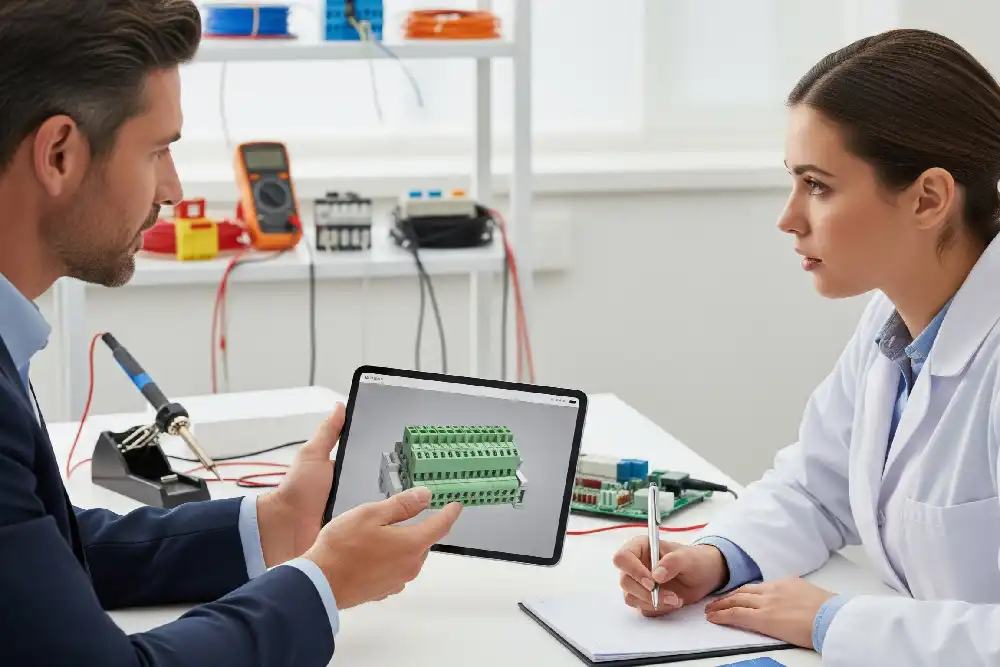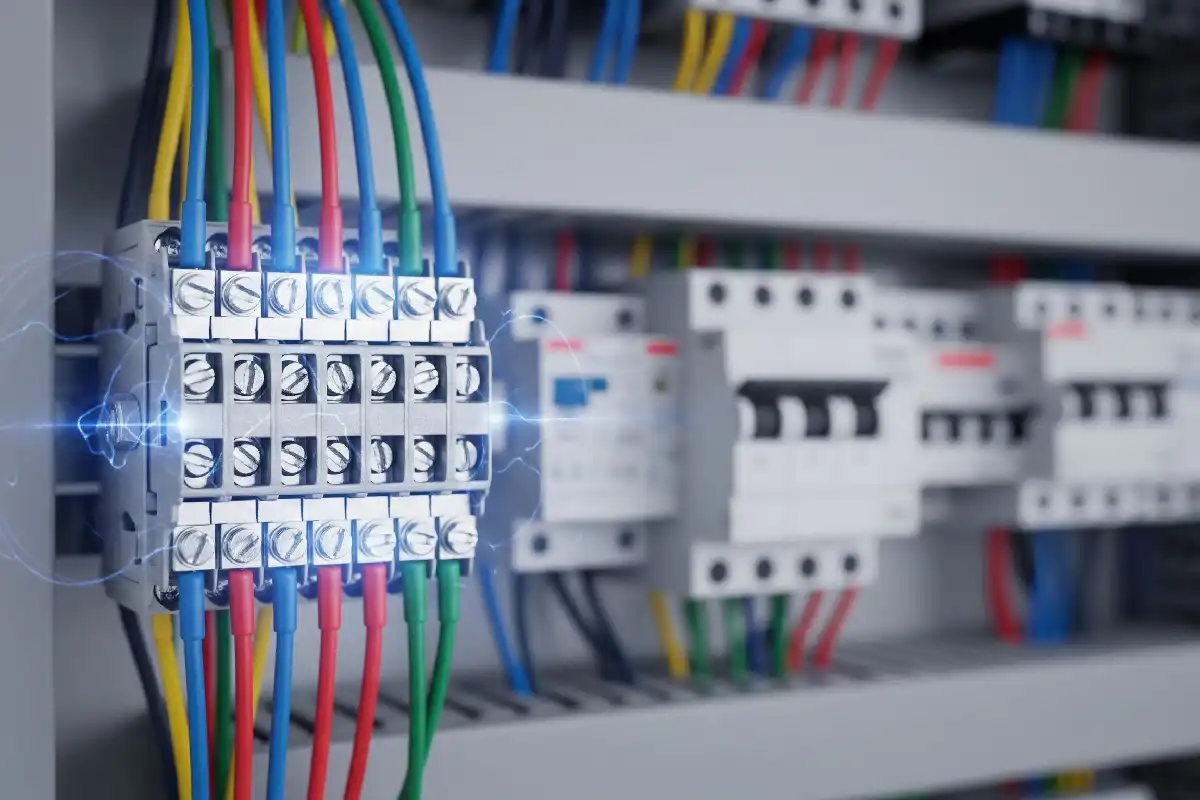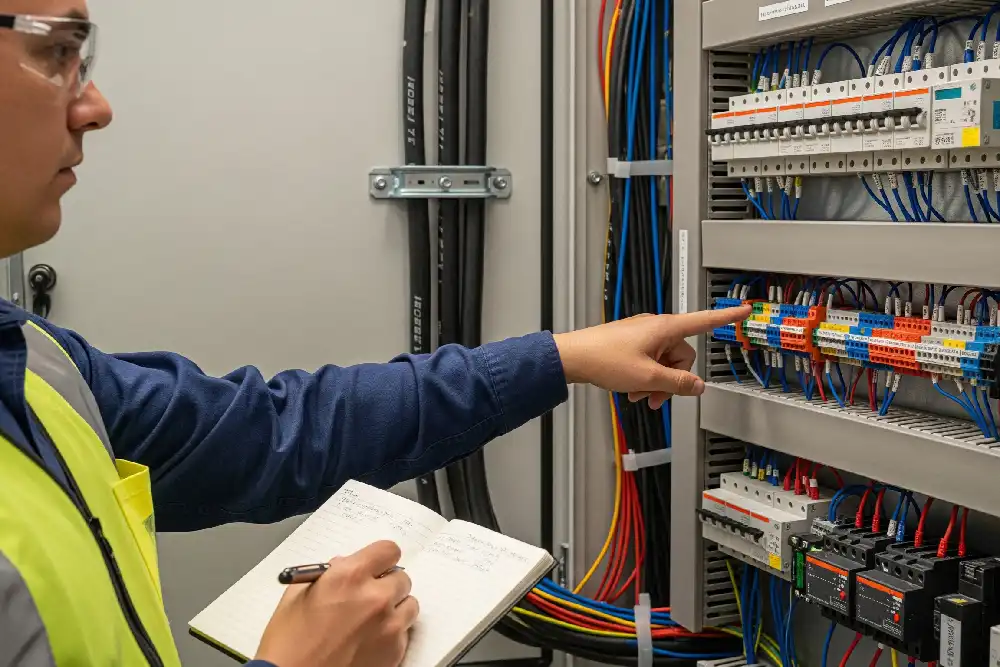Customized terminal blocks are important for special electrical needs. Engineers use these connectors to make things safer and more reliable. Some connectors have overcurrent protection or strong contacts. These can handle shaking and sudden power changes. This helps keep things safe and working well. Spring-cage and push-in connectors stay connected even with lots of movement. It is easier to organize wires with connectors made for special setups. Picking the right terminal block connectors helps teams build strong and safe electrical systems. It also makes them work better.
Key Takeaways
- Customized terminal blocks make strong and safe connections. They do not break from shaking, dust, or water. This helps electrical systems work well.
- These connectors make things safer by stopping short circuits. They follow world rules. They have insulation and built-in safety parts.
- They keep wires neat with clear labels and modular designs. This makes putting them in and fixing them much faster and easier.
- Custom designs fit in small spaces and handle special voltage and current. This makes sure every project gets the right fit.
- Working with trusted makers and picking connectors with higher ratings helps. It stops problems and keeps systems working well.
Benefits of Customized Terminal Blocks
Strong and Safe Connections
Engineers use customized terminal blocks to make strong and safe connections. These connectors have special locks and clamps that hold wires tight. Even if there is shaking or movement, the wires stay in place. Many connectors have covers that keep out dust and water. The covers also stop people from touching the wires by accident. This helps keep the wires steady and stops them from coming loose. Loose wires can cause electrical problems.
Terminal block connectors work with different wire sizes. This makes sure wires fit right and do not slip out. Makers test these connectors to meet IEC rules for shock and vibration. This means they work well even in tough places. The housings do not catch fire easily. The metal parts do not rust. These things help the connectors last longer and stay safe. Touch-safe designs and hidden screws help keep workers safe from shocks or injuries.
Tip: Pick terminal block connectors made for tough places. This keeps connections steady and lowers the risk of electrical problems.
Enhanced System Safety
Safety is very important in customized terminal blocks. These connectors have barriers that stop short circuits. They follow safety rules from around the world. The housings and jumpers are insulated. This keeps people from touching live wires and getting hurt. Terminal block connectors are made for certain current and voltage levels. This stops them from getting too hot or overloaded, which can cause accidents.
Customized terminal blocks often have UL, IECEx, and ATEX certifications. These show they are safe for dangerous places. Factories check them often to keep these safety marks. Built-in safety parts like fuses, circuit breakers, and lights help people watch and protect the system. Color codes and modular designs help people wire things the right way. This cuts down on mistakes and makes the system better.
| Benefit Category | Description |
|---|---|
| Safety Features | Barriers stop short circuits and meet safety rules. |
| Environmental Resistance | Heat-resistant parts, strong locks, and coatings stop rust and keep connectors working in tough places. |
| Connection Flexibility | Choices like screw, spring, and push-in make setup faster and keep wires safe during shaking. |
Organized and Efficient Wiring
Customized terminal blocks help keep wiring neat and easy to manage. The connectors have clear labels and organized layouts. This makes wiring diagrams easier to read and helps fix problems faster. Modular designs let engineers add or remove parts as needed. This makes it easy to change things for each project.
Terminal block connectors keep wires apart and covered. This stops shorts and makes the system work better. You can mount them on DIN rails or panels, which makes setup and repairs simple. Modular systems have ready-made parts that snap together. This helps the system grow and makes future changes easy. It also saves time when setting up or fixing big electrical panels.
- Terminal block connectors help keep wires neat with clear labels and colors.
- They save time compared to old ways of wiring and make building faster and better.
- Standard interfaces help people wire things right and make fewer mistakes.
- Quick connections make setup and repairs faster, and central points keep wires tidy.
Customized terminal blocks can be made to fit special needs, like size, current, insulation, or how they are mounted. This helps use space well and keeps the system neat. Special safety and performance choices make the system safe and organized.
Solving Special Electrical Challenges
Space and Layout Solutions
Engineers sometimes work in small spaces inside control panels. Customized terminal block designs help with these tight spots. Modular construction lets you put up to 90 terminals together. This makes it easier to organize lots of wires. Multi-level and compact terminal blocks save space and keep wires tidy. Din rail terminal blocks can be mounted in different ways. This helps teams fit more connections into small boxes. Color coding and custom printing make it easy to find the right wire. This lowers mistakes and saves time when fixing things. The SUK-2.5M miniature terminal block has many features in a thin shape. It uses half the space of regular terminal blocks. These solutions help move power and control signals in crowded cabinets.
Handling Unique Voltage and Current
Some projects need terminal blocks for special voltage and current needs. Some jobs need high voltage, while others need to handle lots of current. Makers use flame-retardant materials and strong metals for safety. Each terminal block is tested for voltage and heat. This stops overheating and electrical problems. Military-grade terminal blocks can handle up to 1500 V and 20 A. Engineers must check the current and voltage for each job. Din rail terminal blocks make it easy to upgrade or change if needed. Customization makes sure every terminal block fits the job’s voltage and current needs.
| Model | Max Voltage Rating (RMS) | Max Current Rating (60Hz) |
|---|---|---|
| 26 TB 06F | 1500 V | 20 A |
| 26 TB 08F | 1500 V | 20 A |
| 26 TB 10F | 1500 V | 20 A |
| 26 TB 12F | 1500 V | 20 A |
Note: Always pick a terminal block with a higher current and voltage rating than your system. This helps avoid damage.
Durability in Harsh Environments
Terminal blocks need to be tough for hard places. Engineers pick materials like ceramics, brass, and copper because they resist heat and rust. Ceramic terminal blocks can handle heat up to 1650°C and keep electricity safe. Metal parts have coatings to stop rust. Din rail terminal blocks use strong plastics to fight water and shaking. In places with lots of movement or water, locking screws and water-resistant covers keep things safe. Special terminal blocks for cars or boats resist salt, shaking, and chemicals. These features help terminal blocks keep working, even in the hardest places.
- Alumina ceramic terminal blocks stay strong under heat and pressure.
- Modular designs make it easy to replace and fix parts.
- Metals that do not rust keep connections working for a long time.
Terminal Block vs. Standard Options
Limitations of Standard Terminal Block Connectors
Standard terminal block connectors do not work well for special jobs. Many types are too big and do not fit in small panels. Over time, these connectors can stop working well. Dust, rust, and shaking can make them heat up or send bad signals. Screw-type connectors can get loose if there is a lot of shaking. This can make the connection stop working or cause a short circuit. Spring-loaded connectors can lose their grip after many uses. This makes them less safe.
Other problems include:
- Standard connectors can get too hot or melt with high currents.
- They do not work well with high-frequency signals because of extra parts inside.
- Cheap plastics can break in very hot or cold places.
- Open connectors can shock people and need more covering.
- Fixing them takes longer because you must check each one by hand.
- Screw terminals need special tools, and using them wrong can hurt wires.
- Changing wires is hard because screw-type connectors often need all wires redone.
- Sometimes, connectors do not fit because of size or angle differences.
- Loose connections in high-voltage systems can make dangerous sparks.
These problems show why engineers want better connectors for tough jobs.
Customization Success Stories
Customized terminal block connectors can be changed to fit special needs. Companies like Phoenix Contact, WAGO, TE Connectivity, and Weidmüller make connectors that snap together and use strong materials. These connectors can be made for the right voltage, current, and space. For example, the 35A Barrier Terminal Block can be set up in different ways and fits in small spaces.
Many industries have done better after using customized connectors:
- Teams work faster and save money.
- Safety and reliability go up in places like planes, cars, and factories.
- Customized connectors can handle shaking, heat, and strong signals.
- Smart features help watch circuits and fix problems before they get worse.
- Small designs save space but still work well.
- Better covers, circuit protection, and warning lights keep people safe.
- Making them in a green way helps the environment.
| Performance Improvement Aspect | Description and Impact |
|---|---|
| Installation Efficiency | Wiring is faster, with fewer mistakes and less waiting. |
| Space-saving Design | Small, stackable blocks fit tight spaces and crowded racks. |
| Current and Signal Management | Power flows smoothly, signals stay strong, and insulation is high. |
| Durability and Safety | They resist too much power, heat, rust, and shaking; safe materials stop fires. |
| Customization and Scalability | Custom labels, ratings, and ways to mount save money and fit better. |
| Quality Assurance and Support | Each one is tested, has ISO 9001, and comes with help if needed. |
| Application Versatility | Good for robots, phones, power, and tough places. |
Engineers pick customized connectors because they are known to be good. These connectors help teams make systems that are safer, stronger, and work better.
How to Choose the Right Terminal Block Connector
Defining Your Requirements
To pick the best terminal block connectors, you need to know what your project needs. Engineers look at many things before choosing a terminal block connector. They check electrical, mechanical, and safety needs. The table below lists what to think about:
| Criteria Category | Specific Criteria / Considerations |
|---|---|
| Electrical Factors | Current rating (≥150% max system current), Voltage rating, Pole count, Pitch, Wire size/type |
| Mechanical Factors | Wire-entry orientation, Wire-securing method, Module type, Wire-to-housing method |
| Safety Ratings | Compliance with UL and IEC certifications, Flammability rating (UL94V-0) |
| Other Design Considerations | Housing color and markings, Operating temperature rating |
The job’s needs help you pick the right terminal block connectors. Insulation keeps wires from touching and protects people. Shock resistance is important for machines and vehicles. Flame-retardant materials help stop fires in dangerous places. Following safety rules like UL and IEC means the connectors are safe. The wire size and type must fit for a good connection.
Tip: Pick terminal block connectors with current and voltage ratings at least 1.5 times higher than your system’s top load. This helps stop overheating and keeps things working.
Working with Manufacturers
Working with manufacturers helps you get the right connectors. Good suppliers make terminal block connectors that fit your project. Using one brand makes sure all parts work together. Mixing brands can cause problems with how things fit or work.
Manufacturers use special tools and tests to make sure connectors are strong and safe. They watch how connectors are made and test each one. Good suppliers deliver on time and help when you need it. Experts say to pick manufacturers with lots of choices and experience. It is also good to choose suppliers who care about the environment.
When picking terminal block connectors, engineers should:
- Make sure the connector fits the wire size, type, and layout.
- Think about heat, water, and rust in the area.
- Check power needs and safety features.
- Pick the best way to mount for easy setup.
- Use the right steps to make sure wires stay connected.
Note: Getting help from trusted manufacturers can stop mistakes and make your system work better.
Customized terminal blocks fit special electrical needs very well. They help keep things safe and work for a long time. Their design works in tough places and helps people find problems fast. Extra safety parts make systems safer:
- The materials stop heat and rust.
- Colors and labels help fix problems quickly.
- Fuses and lights make the system safer.
Picking the right terminal block needs help from experts. Top makers have choices for many wire sizes and ways to mount. Matching what you need with the right product keeps systems safe and working well.
| Stage | Challenge | Solution |
|---|---|---|
| Installation | Building takes a lot of time | Easy designs help people make fewer mistakes |
| Maintenance | Checking wires is hard | Clear marks make checking easier |
For hard projects, engineers should ask experts for help to get the best results.
FAQ
What makes a terminal block “customized”?
A customized terminal block is made for a project’s needs. Engineers pick the size, shape, material, and features. This helps the block fit small spaces or handle special voltages. It also helps meet strict safety rules.
Can customized terminal blocks improve safety?
Yes. Customized terminal blocks have insulation, barriers, and covers. These parts protect workers from shocks and stop short circuits. Many blocks also follow global safety standards.
How do engineers select the right terminal block?
Engineers write down all the project needs first. They check the current, voltage, wire size, and space. They also look at safety ratings. Many engineers talk to trusted manufacturers to find the best one.
Are customized terminal blocks more expensive?
Customized terminal blocks can cost more at first. But they save money over time. They help stop wiring mistakes, make setup faster, and lower repair costs.
Where do people use customized terminal blocks?
People use customized terminal blocks in factories, power plants, trains, and cars. These blocks work well in places with heat, shaking, or small spaces.
See also
The difference between customized RCCB and standard RCCB
Why choose a customized miniature circuit breaker for your needs
Why Customized RCCB Is the Future of Electrical Safety
How to Pick the Ideal Terminal Block for Your Project
How many wires can be connected to one terminal block





